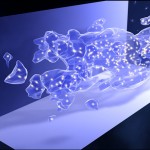 As modern cosmologists rely more and more on the ominous “dark matter” to explain otherwise inexplicable observations, much effort has gone into the detection of this mysterious substance in the last two decades, yet no direct proof could be found that it actually exists. Even if it does exist, dark matter would be unable to reconcile all the current discrepancies between actual measurements and predictions based on theoretical models. Hence the number of physicists questioning the existence of dark matter has been increasing for some time now.
As modern cosmologists rely more and more on the ominous “dark matter” to explain otherwise inexplicable observations, much effort has gone into the detection of this mysterious substance in the last two decades, yet no direct proof could be found that it actually exists. Even if it does exist, dark matter would be unable to reconcile all the current discrepancies between actual measurements and predictions based on theoretical models. Hence the number of physicists questioning the existence of dark matter has been increasing for some time now.
Competing theories of gravitation have already been developed which are independent of this construction. Their only problem is that they conflict with Newton’s theory of gravitation. “Maybe Newton was indeed wrong,” declares Professor Dr. Pavel Kroupa of Bonn University´s Argelander-Institut für Astronomie (AIfA). “Although his theory does, in fact, describe the everyday effects of gravity on Earth, things we can see and measure, it is conceivable that we have completely failed to comprehend the actual physics underlying the force of gravity.”
This is a problematical hypothesis that has nevertheless gained increasing ground in recent years, especially in Europe. Two new studies could well lend further support to it. In these studies, Professor Kroupa and his former colleague Dr. Manuel Metz, working in collaboration with Professor Dr. Gerhard Hensler and Dr. Christian Theis from the University of Vienna, and Dr. Helmut Jerjen from the Australian National University, Canberra, have examined so-called “satellite galaxies”.
This term is used for dwarf galaxy companions of the Milky Way, some of which contain only a few thousand stars. According to the best cosmological models, they exist presumably in hundreds around most of the major galaxies. Up to now, however, only 30 such satellites have been observed around the Milky Way, a discrepancy in numbers which is commonly attributed to the fact that the light emitted from the majority of satellite galaxies is so faint they remain invisible.
A detailed study of these stellar agglomerates has revealed some astonishing phenomena: “First of all, there is something unusual about their distribution,” Professor Kroupa explains, “the satellites should be uniformly arranged around their mother galaxy, but this is not what we found.“Â More precisely, all classical satellites of the Milky Way – the eleven brightest dwarf galaxies – lie more or less in the same plane, they are forming some sort of a disc in the sky. The research team has also been able to show that most of these satellite galaxies rotate in the same direction around the Milky Way – like the planets revolve around the Sun.
More… ➡